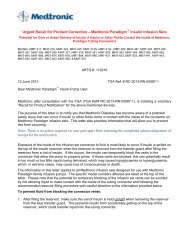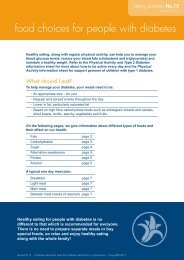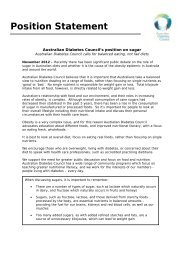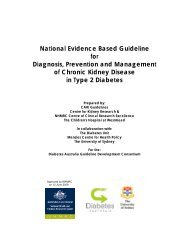Part 6: Detection and Prevention of Foot Problems in Type 2 Diabetes
Part 6: Detection and Prevention of Foot Problems in Type 2 Diabetes
Part 6: Detection and Prevention of Foot Problems in Type 2 Diabetes
You also want an ePaper? Increase the reach of your titles
YUMPU automatically turns print PDFs into web optimized ePapers that Google loves.
Background - Socioeconomic considerationsDiabetic foot problems are a major cost to the health care system. The most commonreason for hospital admission for diabetes is a diabetic foot complication (Young et al,1993a). The DiabCost Australia study (Colagiuri et al, 2003) showed thathospitalisation <strong>and</strong> complications were the major cost drivers <strong>in</strong> people with <strong>Type</strong> 2diabetes.Socioeconomic factors are important barriers to diabetes care. Factors which may<strong>in</strong>terfere with self care <strong>in</strong>clude f<strong>in</strong>ancial difficulties, priorities result<strong>in</strong>g from an<strong>in</strong>dividual with diabetes hav<strong>in</strong>g family caretaker role <strong>and</strong> responsibilities, hous<strong>in</strong>g <strong>and</strong>family problems. While these may apply to any person with diabetes, they are morelikely to apply to a person with a lower socioeconomic status. These barriers havebeen shown to result <strong>in</strong> reduced physical <strong>and</strong> social function<strong>in</strong>g, <strong>and</strong> reduced physical<strong>and</strong> mental health <strong>in</strong> people with diabetes (Hill-Briggs et al, 2002). Also the greaterthe number <strong>of</strong> socioeconomic barriers the greater the effect (Hill-Briggs et al, 2002).While these barriers can have a direct effect on diabetes care eg not be<strong>in</strong>g able toafford medications or attend services, they may also operate through an <strong>in</strong>directeffect. One study showed that when significant socioeconomic barriers were present,77% <strong>of</strong> <strong>in</strong>tervention visits were used to address these non-diabetes specific issues,which reduced the focus on diabetes care as a priority (Batts et al, 2001).Evidence - Socioeconomic considerationsSocioeconomic factors <strong>in</strong>fluence the occurrence <strong>of</strong> diabetes foot problemsFew studies were identified which specifically addressed this issue <strong>in</strong> relation to footproblems <strong>in</strong> people with diabetes <strong>and</strong> further research is required <strong>in</strong> this area. Some<strong>in</strong>direct <strong>in</strong>formation is conta<strong>in</strong>ed <strong>in</strong> the follow<strong>in</strong>g studies.Weng et al (2000) exam<strong>in</strong>ed environmental factors which affect diabetes outcome. Acohort <strong>of</strong> 610 people liv<strong>in</strong>g with<strong>in</strong> the Greater London boundary <strong>and</strong> hav<strong>in</strong>g their firstdiabetes cl<strong>in</strong>ic visit at St Thomas hospital <strong>in</strong> 1982-85 was analysed <strong>in</strong> 1995. Out <strong>of</strong>610 people, 186 had died, 332 were re-exam<strong>in</strong>ed <strong>in</strong> the cl<strong>in</strong>ic <strong>and</strong> 92 were unable tobe traced. Social deprivation was ranked accord<strong>in</strong>g to the Jarman ‘under-privilegedarea’ (UPA) score. People were allocated accord<strong>in</strong>g to the UPA score - >30 wasclassified as a deprived area <strong>and</strong> a score
















